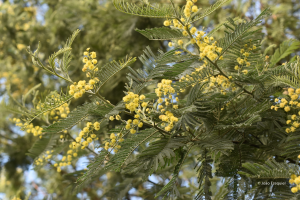They are among the most aggressive invasive species: acacias greatly affect the areas where they grow and the quality of life of “neighbours”. To reduce their negative impact we have to know these invaders well and act in a preventive manner to anticipate possible disruptions. Learn more about this genus and why acacias are an invasive species that threatens biodiversity.
This is mostly a “bad neighbourliness” issue but there is more to it. Invasive plants are exotic and non-native species were introduced into a particular country over time, intentionally or accidentally, in areas falling outside their normal natural distribution. They grow in an uncontrolled and wild manner, compromising the environment, the economy or human health.
The introduction of such plants, now considered invasive, was mostly there for ornamental and soil renovation purposes and to source raw materials. The exploration of new territories has also led to changes in the flora, thus endangering the survival of native plants. This disruption in the natural balance has had a strong impact and the consequences are still there today.
The key-word in this discussion is “control”, or rather the lack of it. Given the inability to control the development of these plants, which reproduce, reach high density and spread to new areas, the balance of habitat and the survival of other plants is thus compromised – invasive species are even considered the second cause of biodiversity loss, strongly competing for food and habitat with native species, thus compromising the survival of the latter.
A good example is acacias – an invasive plant of the genus Acacia, a species of shrubs and trees of the pea family. Among these species, we would like to highlight Acacia dealbata (mimosa), Acacia mearnsii (black aciacia), Acacia melanoxylon (Australian acacia) and Acacia longifolia (spiky acacia):
- Acacia dealbata: this perennial tree, introduced in may places for ornamental purposes, can reach up to 30 meters, standing out for its bright yellow flowers; its pods, on the other hand, take on a reddish-brown colour. It can multiply vegetatively, but also through seeds, which can be transported by animals, thus increasing its ability to propagate. It has the ability to invade areas primarily after fires because it is a species that thrives in fire-prone environments, making forest management and fire protection even more crucial.

- Acacia mearnsii: known as black acacia, has perennial leaves and its flowers are yellow, with a pale tone, while the pods are brown (dark tone). It is similar to Acacia dealbata and stands out for its darker leaves (greyish green in the particular case of mimosas), and the lighter-coloured flowers blossoming later. It’s quite resistant: its seeds, which it produces in large quantities, can remain in the soil for more than 100 years and that is why they develop relatively easily – if they are not stopped. This tree also hinders the survival of native vegetation and is more frequent near water courses and in urban areas.
- Acacia melanoxylon: can reach up to 40 meters in height, has perennial leaves and pale and yeallow flowers, and reddish-brown pods. It was introduced, among other reasons, to provide shade and soil fixation. This tree prefers granite soils and has a larger capacity to resist periods of drought, intense winds and very high temperatures when compared to the surrounding vegetation. They are more frequent on the edges of roads and watercourses, and around forests.

- Acacia longifolia: it is the smallest of the aforementioned examples, a bush or a small tree that does not exceed eight meters. It has a perennial leaf and its flowers, bright yellow, are united in axillary spikes, hence the name spike acacia. Its pods, on the other hand, have a cylindrical shape, and stand out from Acacia melanoxylon as regards the seeds, for example, for its off-white and not orange funiculus (the filamentous structure connecting the seed to the fruit). One of the advantages of this tree in particular is that is helps control erosion, which also motivated its introduction. But is also an invasive species and can be found, among other places, in coastal dunes. It can be found also on roadsides or mountain areas.

Acacias: need for intervention
There are more than ten species of invasive acacias found in Portugal and that is why identifying them, to act in time, is not always easy. Furthermore, the vast majority of forests in Portugal are private, thus making the intervention process more difficult.
The negative influence of acacias is there, for example, in riverside areas. The study “Invasion of temperate deciduous broadleaf forests by N-fixing tree species – consequences for stream ecosystems. Biological Reviews“, from the University of Coimbra, warns about acacias and how they can affect plants near streams. This is because the invaders change the natural balance of the habitat as they can change the characteristics of organic matter, the amount of water and also its concentration of nutrients.
Portuguese legislation provides for the risk of biodiversity loss due to the action of invasive plants, in particular Decree-Law No. 92/2019. This decree states that “the proliferation of exotic species that threaten ecosystems, habitats or species is identified as one of the main threats to biodiversity”, and so therefore “the introduction into nature of exotic species is subject to authorisation, incurring offenders in administrative offence sanctioned with fines”.
Taking action is paramount, given the serious consequences of this proliferation of invasive species which negatively affect biodiversity – invasive plants are considered one of the main causes of biodiversity loss along with pollution, over-exploitation and habitat loss, thus aggravating climate change. In 2015, data from the National Forest Inventory indicated that forests where acacias were predominant exceeded 8,400 hectares in Portugal, although it is realistic to point to a higher occupation of several tens of thousands of hectares, where the species is present, but is not predominant. Managing forests is, therefore, fundamental.




